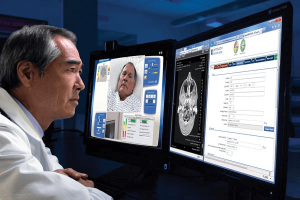Healthcare is a difficult industry to innovate. It’s mired in bureaucracy, prone to siloed operational practices and highly resistant to change. In the Internet of Things (IoT) age, people are more connected than ever before but, in many ways, medical care still looks very similar to the way it’s always been practiced. IoT is the bright future meant for greater communication, greater convenience and greater care. Despite challenges with making changes in healthcare, the possibilities for the Internet of Medical Things (IoMT) are infinite.
Healthcare for Rural Patients
For those struggling with chronic health conditions, getting in front of a doctor often means taking time from work or family commitments. It means arranging transportation for a long commute to the appointment and hoping that it’s reliable. And then repeating this over and over again.
Telemedicine is an option for those living in remote areas. Patients can used specialized medical equipment to measure and send biometric data, receive care and speak with their health provider via the internet. Doctors are able to assess their patients and adjust treatment plans without having to see that patient face-to-face. In this case, both the provider and the patient benefit from better continuous care and higher satisfaction with their experience.
Healthcare Administration
Providing health care is a complicated process with many moving parts. Whether it’s monitoring patient care, managing documentation, or overseeing workflow, IoMT has something to offer.
In a large hospital, the management of medical resources can be costly due to lost or stolen equipment. These assets can be tracked by attaching sensors (RFID or Bluetooth) so staff can locate them at any time or place. This solution can prevent loss and reduce theft which saves both time and money for management.
Similarly, a tracking system can also be used for patient care and flow-through in a medical center. Small microchips in patient wristbands and staff identification badges can track times and locations of both. This can assist with assessing bottlenecks in service and monitoring wait times, intake and discharge processes.
Documentation & Data Management
Quality healthcare depends on the collection, organization and proper dissemination of large amounts of data. Tracked biometric data, assigned staff resources and patient processing are just a few examples of the information that must be managed. IoMT-equipped medical devices can send biometric information to relevant electronic health record systems. Doctors can receive up-to-date statistics on their patients without delay and adjust treatment orders in the moment. Information across inter-connected systems can be clear, consistent and available to those who need it when they need it.
The Future of IoMT
The future of IoMT is also the future of healthcare. Staying competitive and cost-effective in an industry that demands exceptional quality means embracing new ways of doing business. Consumer choice is shaped by technology that improves access and adds convenience. Leveraging that same technology will help those in this industry improve patient care and operational efficiency.























